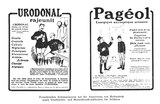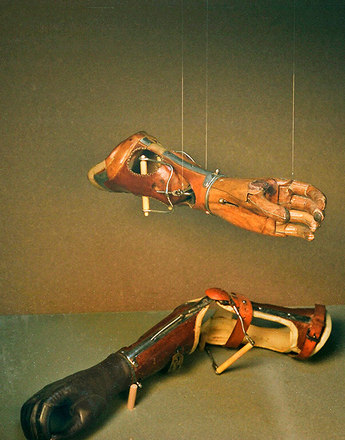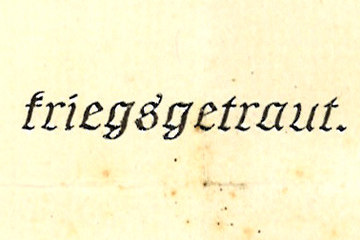The various military leaders pursued different strategies to prevent the spread of venereal diseases within the army.
The distribution of prophylactic aids was seen as an important way of curbing venereal disease. The Austro-Hungarian troops were equipped by the military administration with “Viro packages” consisting of Vaseline, condoms and an antiseptic solution or soap. There was also a Protargol solution that had to be infused into the urethra for disinfection. According to the Wiener medizinische Wochenschrift this measure was instrumental in reducing the incidence of venereal disease towards the end of the war.
Because of their increasing spread, in December 1916 the Ministry of War published an “Instruction for soldiers contracting syphilis during the war”. The Austro-Hungarian soldiers were also given a brochure entitled “How to protect yourself from syphilis” in nine languages – German, Hungarian, Czech, Polish, Ruthenian, Croatian, Slovenian, Romanian and Italian. The leaflets and brochures contained information about the various infectious diseases like gonorrhoea and syphilis and about ways of preventing them. Medics in the field and company officers were meant to inform the men about venereal diseases and instruct them on prophylaxis.
Within the Austro-Hungarian army there was no uniform regulation for punishing infected military personnel. Punishments ranged across the whole spectrum; more draconian measures were usually reserved for soldiers who failed to report the disease. Those who contracted a venereal disease behind the lines were tried on their return to the front. They were only punished if it could be proved that they had done nothing to protect themselves. Deliberate infection of others was also punishable by detention or imprisonment. In the Serbian army all soldiers with venereal diseases were punished.
Special venereal clinics were set up to combat the spread of venereal diseases and to offer suitable treatment. Salvarsan, an arsenic compound, and mercury ointment were the commonly used medicaments. The men and women were often discharged much too early while they were still contagious. Soldiers were generally treated in clinics at the front or behind the lines and were not therefore exposed to the same stigmatisation as women at home, for whom the military authorities set up special women’s clinics. In many cases women were admitted to the clinic on the mere suspicion that they had a venereal disease by the local police, who publicly arrested the suspects. The social disgrace was frequently accompanied by financial problems, because many employers refused to employ women discharged from the venereal clinics, leaving them to fend as they could without a job.
In a report by Provincial Health Inspector Witsch about the women’s clinic in Schwaz, Tyrol, the social stigmatisation of diseased women was evident. Their internment, it said, “is carried out by the police as if it was a question of imprisoning and protecting the public from criminal elements. […] Many women state that they were taken from their work or home by the police without being given any opportunity to arrange their things and get clothing and underwear. They were simply led off to the station without explanation and taken to Schwaz. […]. In some cases the women were perfectly healthy and even intact virgins.”
The different methods used within the Austro-Hungarian army to combat venereal diseases finally had an effect. Whereas 12.2 per cent of the troops suffered from a venereal disease in 1915, the level had sunk by 1916 to 6.4 per cent.
Translation: Nick Somers
Biwald, Brigitte: Von Helden und Krüppeln. Das österreichisch-ungarische Militärsanitätswesen im Ersten Weltkrieg. Teil 2, Wien 2002
Breitenstein, Max/Koropatnicki, Demeter: Die Kriegsgesetze Österreichs. V. Band, Wien 1918
Dietrich, Elisabeth: Der andere Tod. Seuchen, Volkskrankheiten und Gesundheitswesen im Ersten Weltkrieg, in: Eisterer, Klaus/Steininger, Rolf (Hrsg.): Tirol und der Erste Weltkrieg, Innsbruck 2011, 255-275
Hirschfeld, Magnus/Gaspar, Andreas: Sittengeschichte des Ersten Weltkrieges, 2. Auflage, Hanau am Main 1966
Überegger, Oswald: Krieg als sexuelle Zäsur? Sexualmoral und Geschlechterstereotypen im kriegsgesellschaftlichen Diskurs über die Geschlechtskrankheiten. Kulturgeschichtliche Annäherungen, in: Kuprian, Hermann J. W./Überegger, Oswald (Hrsg.): Der Erste Weltkrieg im Alpenraum. Erfahrung, Deutung, Erinnerung. La Grande Guerra nell’arco alpino. Esperienze e memoria, Innsbruck 2006, 351-366
Quotes:
“is carried out by the police ...": Bericht des k. k. Landes-Sanitäts-Inspektors Dr. von Witsch über eine Besichtigung des k. u. k. Frauenspitales in Schwaz am 28.8.1917, quoted from: Überegger, Oswald: Krieg als sexuelle Zäsur? Sexualmoral und Geschlechterstereotypen im kriegsgesellschaftlichen Diskurs über die Geschlechtskrankheiten. Kulturgeschichtliche Annäherungen, in: Kuprian, Hermann J. W./Überegger, Oswald (Hrsg.): Der Erste Weltkrieg im Alpenraum. Erfahrung, Deutung, Erinnerung. La Grande Guerra nell’arco alpino. Esperienze e memoria, Innsbruck 2006, 363 (Translation)
-
Chapters
- Separation of husbands and wives and sexual mobility in the First World War
- Dwindling birth rates during the First World War
- "Mobilisation of the cradle"
- State control and social stigma
- Abstinence and satisfaction of needs
- Combatting venereal diseases in the Austro-Hungarian army
- “Resist from the outset”
- Sexual relief for soldiers
- Prevention or punishment
- Sexual assault in the First World War
- Sexual violence in Allied war propaganda






